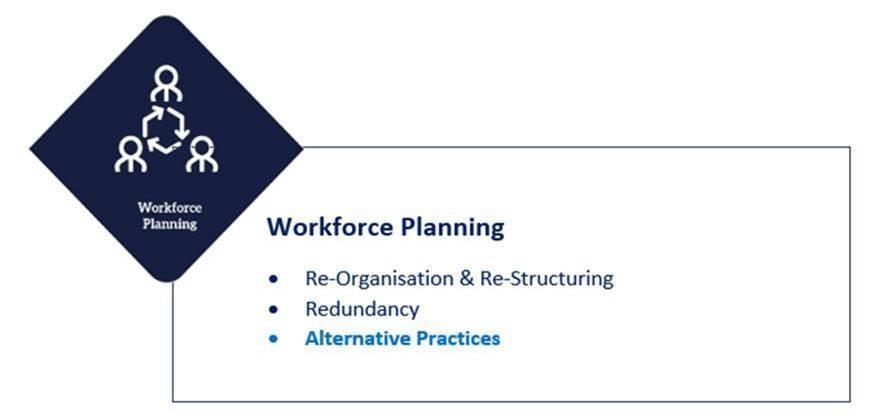The Journey Back to the Workplace: Alternative Practices

Alternative Practices
In the current environment workforce planning is instrumental in the sustainability and longevity of an organisations purpose and is a practice that supports an understanding on whether an organisational structure is fit for future purpose.
As HR practitioners and Leaders manoeuvre through the easement of government restrictions and the planned phased reductions in government supports, the need for organisations in the community and voluntary sector to implement some form of change is inevitable. Having already discussed reorganisation and restructuring, as well as the considerations around redundancy, the final stream to flow from workforce planning is that of alternative practices.
Outlined below are the key steps and salient points to be considered when adopting a framework conducive to alternative practices.
Considerations of Alternative Practices - Action Points for HR Practitioners and Leaders
Employers cannot unilaterally impose changes to an individual’s contract of employment but where an organisational (business) case has been established and consideration has been given to the impact of the current pandemic and impending recession the following should be considered.
1. Check the Contract of Employment
- Check the contract for a variation clause which permits an organisation to make changes of a minor, administrative, or non-fundamental nature to an employee’s terms and conditions.
- Consider what notice should be provided for any proposed changes under a variation clause.
- Where no such clause exists then any proposed minor, administrative or non-fundamental nature change may only be done with agreement from the employee.
2. Consider any Major, Non-Administrative or Changes of a Fundamental Nature
In this situation the employer must seek to consult with an employee with a view to reaching agreement prior to implementing any proposed changes, practical steps include:
- Selecting employees through fair and reasonable means.
- Arranging a meeting to explain the rationale of any proposed changes.
- Seeking and considering the views of affected employees in response to the proposals.
- Examining all alternatives where and if proposed.
- Seeking agreement from the employee and providing a reasonable period of notice before the changes take effect.
- Putting the proposed changes in writing, citing the nature and duration of the change and outlining how it will impact on terms and conditions, such as service and remuneration.
- All written notification of changes must be provided within one month of the changes taking effect in accordance with the Terms of Employment (Information) Act, 1994.
3. Considerations of Layoff/ Short time
The Redundancy Payments Acts 1967-2014 make provision for a period of lay-off or short time to be applied where the employer is of the belief that such measures are temporary and that the employer is unable to provide an employee with work for which they are contracted either in a full time capacity or for a lesser period as laid out in the definition of short time.
- Check for the existence of an express or implied term and condition that lay-off or short time can apply.
- Where neither an express nor implied right exists, the employer must consult with the Employee and seek their agreement to apply a period of lay-off or short time.
- Act in a reasonable manner, explain the rationale, apply fair and objective selection procedures, provide a reasonable period of notice.
Steps in Realising Alternative Practices of Workforce Planning
1. Planning & Analysis
The first step in realising alternative practices of workforce planning is to consider the approach to be taken.
In order to do this in a planned way it is essential that employers identify the key challenges faced by the Organisation, both internally and externally, especially where those in the Community and Voluntary sector have had significant constraints in fundraising opportunities and/ or restrictions from funders. This means that an employer will need to gather information on the workforce to understand what skills and experience they currently have, what challenges have presented themselves in terms of working practices and what financial implications will impede the progress of organisational objectives and the pursuit of the vision and mission in the short, medium and long term.
Once you have gathered all the essential data you must then analyse what this means for your organisation. This understanding is an essential component of justifying organisational necessities and prerequisites when engaging with employees and creates an awareness of organisational needs that will support any decision to be made in terms of alternative practices.
2. Determining the Alternative Practice – fit for future purpose
Following the analysis of all essential data you must then determine which alternative practice will fit the current and future purpose of your organisation.
There are different approaches that can be taken under workforce planning that will support the organisational case in implementing change. These include implementing layoffs, placing employees on short time or reducing the working hours or working days.
An understanding of the status quo will support the identification of what direction the Organisation needs to go in order to determine which practice should be implemented.
Other considerations will factor into the implementation stage such as contractual obligations as well as the Employer Value Proposition in the retention of staff, all of which are important factors in determining which alternative practice will support any changes stemming from workforce planning, thus ensuring the organisation is not only fit for current but future purpose.
3. Developing an Action Plan
With the organisational case developed and the alternative practice identified HR professionals must now determine the impact on the workforce.
Questions to ask include:
- what are the contractual arrangements in place that could impede furtherance of the organisational objectives, such as express or implied terms and conditions,
- what message should be conveyed to gain buy-in from employees and what approach should be taken in this communication,
- what are the necessary changes to work practices and terms and conditions that will align your workforce to present and future needs.
- What is the expected duration of implementation any alternative practices proposed.
From this process the risks and challenges that may present will be identified and this will determine what actions should be taken and how the message should be conveyed.
It is at this point that HR should develop an action plan that will support the introduction, communication and implementation of alternative practices to best achieve organisational needs that are fit for current and future purpose. As the greatest impact will be felt by your workforce it is essential that HR play a pivotal role in this process from the analysis and development right through to the implementation stage and timings thereof.
4. Implementation
At this point the organisation and HR in particular will have a full understanding of the financial conditions in which the organisation is operating, will understand the goals of the Organisation in the current market, the organisational case supporting those goals and will be fully informed on the skillset of staff necessary in the adoption of alternative practices.
With a project plan developed and risks identified under a live register, implementation of plans can then commence. Effective communication is essential at the implementation stage and will support a smoother transition of employee buy-in at the engagement stage and by providing as much transparency as possible this will help alleviate any pushback from employees.
HR will play an integral role in onboarding the workforce to any proposed changes or indeed in engaging and consulting with Unions. Compliance risk at this point will be front and centre in all negotiations and it is therefore essential that HR engage in procedurally correct practices to mitigate the risks from the employment law, employee relations and industrial relations perspective. The onboarding process taken will act as a signal to the success or failure of the implementation stage itself so HR must ensure consistency and best practice at all times.
5. Embed, Review and Realign
To successfully embed changes to your workforce it is vital that you include a review process that will ensure the objectives are being met.
It can arise that certain elements of the implementation are not realised, and HR professionals will need to regularly review the actions taken in order to understand and embed the results. Where regular reviews take place, any new challenges will be identified which will in turn prompt responses that are solutions focused to continue with the embedding. The review process may also drive realignment in the achievement of working in the new normal thus creating a workforce that is resilient and flexible, working to the right size, in the right manner, at the right cost and with agility.
See also: Returning to the Workplace Supports

Supported by Medtronic
